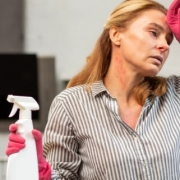Lawsuit Settled Over Mold in Iowa State Building
Some workers at the Iowa Department of Corrections building have settled a lawsuit they filed against the owner over damage to their health, citing water leaks, air-quality problems and high levels of mold.
The payment of the $175,000 settlement for 10 plaintiffs will be split equally between the state and the not-for-profit company that owns the building, Community Resources Corp., said Jim Wayne, the director of the Iowa Department of Corrections for the 7th Judicial District. The plaintiffs’ attorney, Dennis VanDerGinst, cited a confidential settlement.
Eight lawsuits filed by the employees accused Community Resources of negligence for allegedly failing to identify and repair water leaks, ignoring visible mold and failing to prevent mold growth or repair raw sewage leaks. Community Resources then brought the state, the building’s only tenant via the Department of Corrections, into the lawsuit as a third-party defendant, VanDerGinst said.
Wayne said the Department of Corrections for the 7th Judicial District continues to look at moving out of the building since fixing the problems could cost more than the $10.5 million appropriated last year by the Legislature for a move and expansion. “You end up paying almost as much as new construction and possibly even more and not getting more capacity,” he said.
Wayne estimated that the Corrections Department has spent $75,000 tackling the issue by cleaning, operating dehumidifiers and paying more attention to water leaks, toilet overflows and ensuring that all areas are clean and dry. Those measures have removed “95 percent of the issue” for the 55 workers currently employed in the building. “The primary cause was indoor humidity and indoor condensation,” he said. “What we needed to do was increase the fresh-air ventilation and pay attention to some heating and cooling issues. We’ve got a 1965 heating and cooling technology,” Wayne added.
Don McLeod, the Community Resources administrator whose office is in the building, said he is “not concerned at all” and that any problem is “removed and has been.”
Some employees listed as plaintiffs in some of the lawsuits had talked previously about their experiences. A former secretary at the building, Susan Purdy, was diagnosed with multiple sclerosis in September 2000, but that diagnosis was discarded a short time later when a spinal tap ruled out any presence of the disease. Purdy said she suffered from nausea, headaches, fatigue and chronic sinus trouble.
A physician in Albany, N.Y., found evidence of different types of toxic mold, and tests showed mold-exposure damage to her immune and central nervous systems, Purdy added.
Willie Stevenson, a guard at the building from 1987 to April 2001, also filed suit. He blamed struggles with brain tumors, a seizure disorder and hearing, eyesight and memory problems on mold levels in the building. Eight employees filed workers’ compensation claims, and Dr. Richard Lipsey, a toxicologist, took cotton swab samples from the building in February 2002, revealing what he said are toxic mold levels as much as 12,000 times those found in an average household.
The Iowa Occupational Safety and Health Administration did not cite the facility for those high levels because there are no standards governing toxic molds.


 Image by
Image by  ©Photo Courtesy of drfungus.org
©Photo Courtesy of drfungus.org  Indoor Science
Indoor Science  ©The Military Times
©The Military Times 



